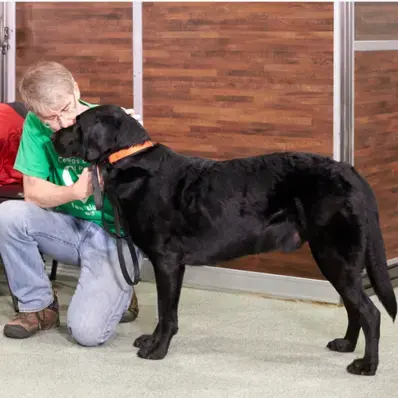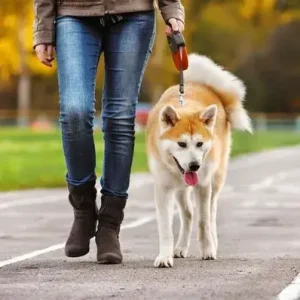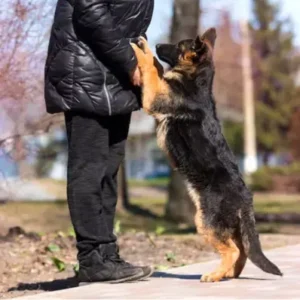Characteristics of a Good Therapy Dog
Not every dog is suited for therapy work. Here are the key characteristics of an ideal therapy dog:
- Friendly and Sociable: Must enjoy being around people and other animals.
- Calm and Gentle: Should remain composed in various environments.
- Trainable: Should respond well to commands and be eager to learn.
- Non-Aggressive: Must not show any signs of aggression or fear.
- Healthy: Must be in good health and well-groomed.
Steps to Train a Therapy Dog
Training your dog starts by building a solid foundation of basic commands. These commands establish good behavior, which will be essential as you move on to advanced therapy-specific training. However, it’s important to note that training a therapy dog is different from training a service dog.
Start with Basic Obedience Training
Begin by teaching your dog essential commands such as:
- Sit
- Stay
- Come
- Down
- Leash Walking
Use positive reinforcement techniques such as treats, praise, and petting to encourage good behavior.
Socialize Your Dog
Expose your dog to different environments, people, and other animals. Take them to busy parks, pet-friendly stores, and family gatherings. Socialization helps your dog become comfortable in new settings.
Desensitize to Various Stimuli
Therapy dogs must remain calm around medical equipment, loud noises, and sudden movements. Gradually expose your dog to these stimuli in a controlled manner.
Build Confidence
Encourage your dog to explore new environments and interact with different people. Confidence-building exercises can include agility training or navigating through obstacle courses.
Advance to Specialized Training
Once your dog has mastered basic obedience, focus on commands specific to therapy work, such as:
- Visit: Encouraging the dog to approach and interact with a person.
- Hug: Teaching the dog to rest its head gently on someone’s lap.
Certification and Registration
After completing training, you’ll need to get your dog certified by a recognized organization. Here are some well-known certification programs:
- Pet Partners
- Alliance of Therapy Dogs
- Therapy Dogs International (TDI)
Most organizations require:
- Proof of basic obedience training
- A health checkup from a veterinarian
- An evaluation of your dog’s temperament and behavior
Benefits of Therapy Dogs
Therapy dogs offer numerous physical, emotional, and psychological benefits, including:
- Reducing Stress and Anxiety: Interacting with a therapy dog can lower cortisol levels and promote relaxation.
- Improving Mood: Therapy dogs can increase levels of serotonin and dopamine, the “feel-good” hormones.
- Boosting Physical Health: Petting a dog can lower blood pressure and heart rate.
- Enhancing Social Interaction: Therapy dogs encourage communication and socialization, especially in group settings.
- Helping with Recovery: In rehabilitation centers, therapy dogs can motivate patients to engage in physical activities.
Can Any Dog Become a Therapy Dog?
Not every dog is cut out to be a therapy dog. For a dog to succeed in this role, it needs certain qualities. A therapy dog should be calm, friendly, and comfortable around people, even in unfamiliar places. Importantly, the dog breed doesn’t matter as such—what matters most is temperament.
But still, the most popular dog breeds are:
- Labrador Retriever
- Golden Retriever
- Poodle
- Cavalier King Charles Spaniel
- Beagle
- Bernese Mountain Dog
- Bulldog
Therapy dogs need to be social, non-aggressive, and tolerant of people who may be ill, anxious, or physically impaired. They should also have basic obedience skills and respond well to commands.
To determine if a dog has the right qualities, many therapy dog programs require passing the Canine Good Citizen (CGC) test. This test evaluates a dog’s behavior and temperament, checking for things like how well they walk on a leash, respond to commands, and interact with strangers. Passing the CGC test is often the first step to becoming a certified therapy dog, though additional specialized training may be needed.
Where Can Therapy Dogs Work?
Therapy dogs are welcomed in various settings, including:
- Hospitals and Nursing Homes: Providing comfort to patients and residents.
- Schools and Universities: Helping students cope with stress and anxiety.
- Rehabilitation Centers: Encouraging patients during recovery.
- Disaster Response Situations: Offering emotional support to victims and first responders.
Tips for Successful Therapy Dog Training
Now that you know what qualities make a dog suited for therapy work, here are some essential tips to help ensure successful therapy dog training.
- Be Consistent: Use the same commands and rewards to reinforce behavior.
- Stay Patient: Training takes time, so don’t rush the process.
- Use Positive Reinforcement: Reward good behavior with treats, praise, and affection.
- Maintain Good Health: Keep your dog up-to-date on vaccinations and grooming.
- Monitor Stress Levels: Make sure your dog enjoys therapy work and isn’t overwhelmed.
Common Challenges and How to Overcome Them
While training a therapy dog can be rewarding, it’s not without its challenges. Here are some common obstacles you might encounter and practical solutions to help your dog succeed.
Fear and Anxiety in New Environments
Solution: Gradually expose your dog to different settings and use positive reinforcement.
Overexcitement Around People
Solution: Teach impulse control by using commands like “sit” and “stay.”
Managing Distractions
Solution: Practice in environments with various stimuli and reward focus.








